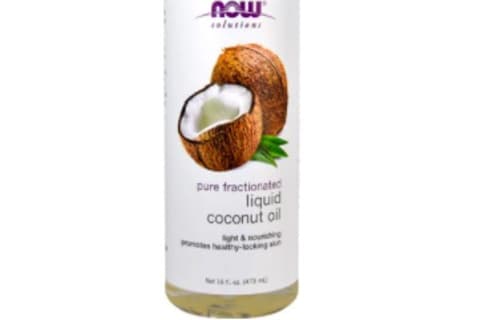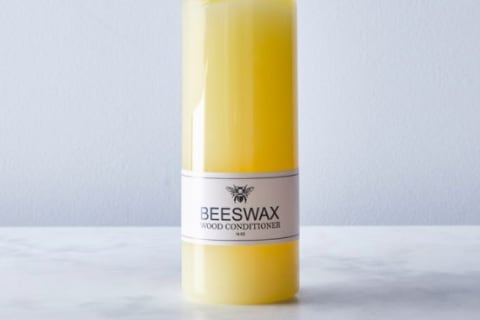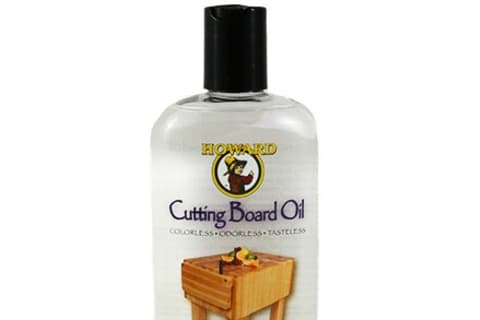Advertisement
How To Use Cutting Board Oil To Keep Your Prep Space Clean & Conditioned

Wooden cutting boards take a real beating and, as such, need to be pampered every now and again. In addition to giving your board an occasional deep clean, you should also be oiling it every few weeks.
Here's why it's important to lather up your prep surface and how to do so safely.
Why oil a wooden cutting board?
Coating a wooden cutting board with oil (also known as seasoning) helps keep it smooth, shiny, and well sealed.
Oil repels water, preventing moisture-loving bacteria and germs from settling into the grooves on your board. So even if you don't cook all that much, oiling is still a good habit to get into.
To further drive home why oiling is so essential, Tarek Alame and Tiffany Yu, the co-founders of California-based cutting board company Sonder LA, compare a dry board to dry hands: "The more often you wash your hands, the dryer they get. When your hands get too dry, your skin may start to crack. You want to oil your board before the cracking happens," they explain.
Oiling also makes your board look better, by drawing out its natural color and dulling the appearance of knife marks.
Oils to use.
OK, so oiling a board is important—but you can't use just any ol' oil sitting in the depths of your pantry to do it. You'll need one that won't go rancid once it's exposed to air. Here are two options that are safe, effective, and easy to find in the store:
Beeswax
While not technically an oil, team Sonder LA says that beeswax is an excellent option for seasoning boards. Like oil, it repels water—while forming a super-tight, protective seal. Beeswax can also add a nice luster to a board's wood and help extend its life span, they add.
Coconut oil
Coconut oil is a personal favorite of holistic chef Kristin Cole, who appreciates that it's natural, nutrient-rich, easy to find in the food store, and serves multiple purposes at home.
The Sonder LA team considers coconut oil a good option as well, but they add that it should be fractionated. Fractionated oil is processed in a way that removes its long-chain fatty acids, making it liquid at room temperature and less likely to go rancid on your board.
3. Mineral oil
The most popular option for treating boards is mineral oil—a colorless, odorless oil that's nondrying and acts as a lubricant. "Mineral oil has properties that prevent water absorption, as well as protect against bacteria," Alame and Yu explain.
While food-grade mineral oil is approved safe by the FDA and there's no evidence that it's harmful in a household setting, it's a byproduct of petroleum production. For this reason, Kristin steers clear of it ("I don't really want [it] touching any food surface," she says). The Sonder LA team does use it and finds it effective.
Ultimately, it's a judgment call about what you're comfortable bringing into your kitchen. Note that most beeswax-based wood oils also contain mineral oil.
Oils to avoid.
Most of the oils in your kitchen can't be used on your cutting board. They're too high in fat, and once oxidized, this fat will turn rancid and ruin your board. "They also don't provide all the needed nutrients for the wood," the Sonder LA team adds.
Here are a few oils you're better off saving for cooking:
- Corn oil
- Cottonseed oil
- Canola oil
- Grapeseed oil
- Olive oil
- Rapeseed oil
- Sunflower oil
- Sesame oil
- Soybean oil
How often to oil your cutting board.
How often to season your board will depend on how much you're using and washing it (remember the dry, cracked hands analogy?).
If you pull out your board at least once a day, Alame and Yu suggest oiling it every two to three weeks. If you only use it a few times a week, oiling every three to four weeks should be OK. They add that end grain boards (the ones that showcase the rings, or "ends," of a tree) tend to dry out faster and might need to be treated more often.
If you're not one to follow a schedule, you can just keep an eye out for when your board looks like it could use some TLC. "I run my hands across my board every time I use it and notice the condition of the surface or whether it's starting to lose its natural luster, " Cole says.
She adds that oiling your board when the seasons change can be a nice way to prep it for a new batch of flavors, ingredients, and cooking styles.
How to oil your board:
- First, make sure your board is clean and disinfected (here's a primer on how to do that using salt, lemon, and baking soda).
- Dry your board completely.
- Use a towel or rag to rub about a tablespoon of your oil of choice into your board, going with the grain. Turn over and do the same on the other side. Rub down those sidewalls, too!
- Let your oil sit for 20 minutes before wiping any excess off with a clean towel.
- Lean your board against a wall so it can dry completely before you use it again, preferably overnight.


